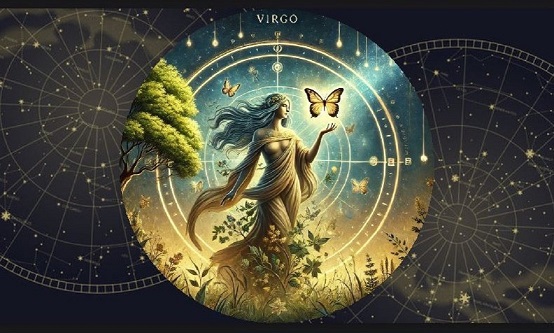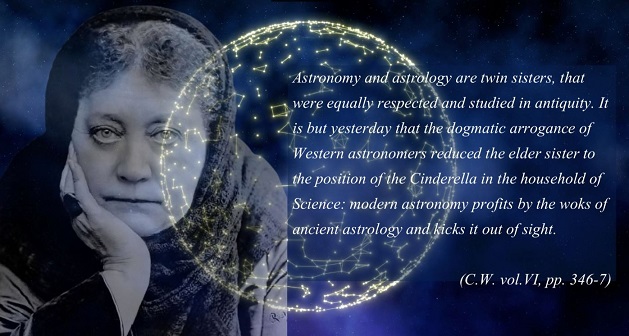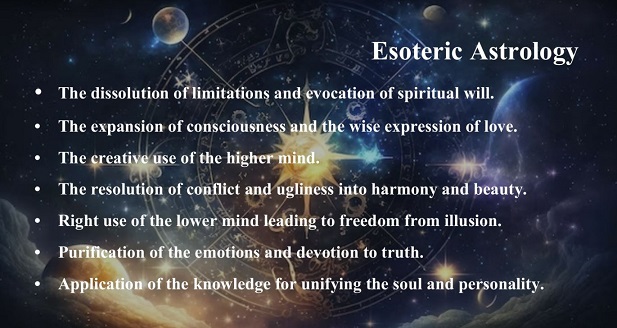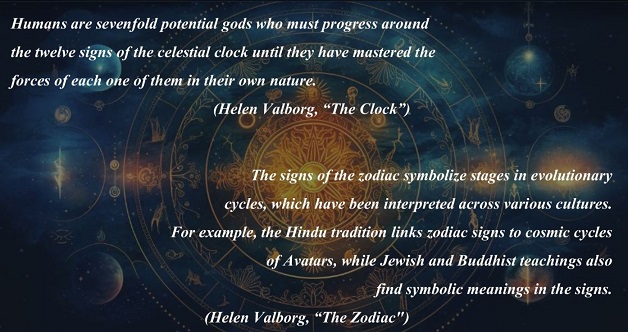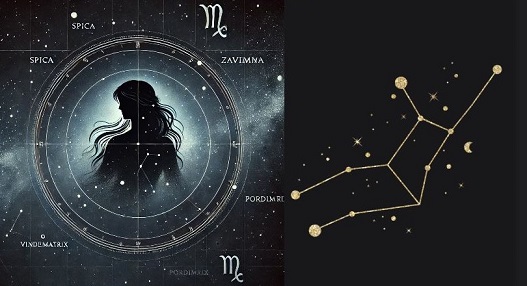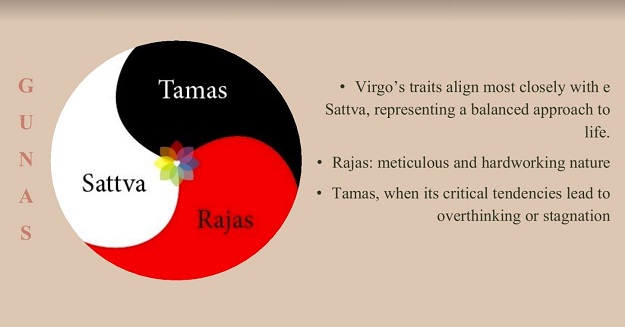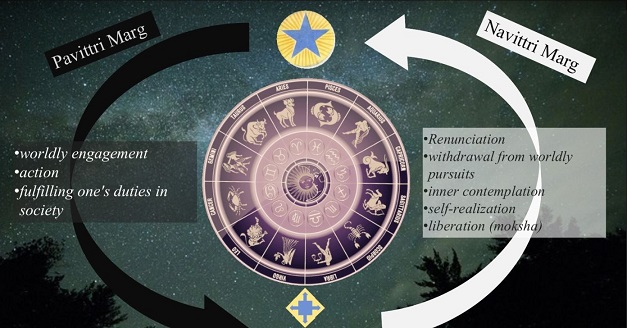Catalina Isaza Cantor – Colombia, India (Adyar)
The author
[Based on a Zoom presentation delivered on Saturday September 21 for the United Lodge of Theosophists, San Diego, as a part of their Aquarian Series.]
Before going into the subject, I feel compelled to make the disclaimer that I am not anything closer to an astrology expert, but just a student of theosophy, a learner on the path. However, I have always felt fascination for the intricacies of astrology and the zodiac, the symbolism which is proper to it and the possibilities of a practical application of the astrological insights to the daily life. That is why I delved into it, seeing it as a challenge and an opportunity of learning. I really believe that the study of any science, from the esoteric point of view, has the big purpose to trigger in us possibilities of reflection insofar as all esoteric study reveals possibilities of understanding our human journey from the point of view of the universal and immanent.
In that spirit, I will focus on certain aspects of the archetype of Virgo. Zodiac signs can be viewed as archetypes because they represent universal patterns of human behavior, psychological traits, and spiritual lessons that resonate across cultures and time. They help us understand the deeper layers of personality, our inherent drives, and the cyclical nature of life's challenges and growth. They offer a symbolic framework that provides insight into our own nature and the collective human experience, pointing a path to self-awareness and transformation. Each sign embodies a distinct energy or force that reflects different aspects of existence.
Before going deeper into the archetype of Virgo, I would like to share some insights about astrology and the zodiac from the theosophical and esoteric point of view, using for that not only some personal insights, but also texts by Helen Valborg, HPB, James Davis, Robert Thibodeau, among others.
Astrology is the study of how the movements of stars and planets influence human life from birth to death. It is considered the oldest science, from which other sciences, including astronomy, evolved. It is applied through horoscopes, using astronomical calculations and data gathered over time, making it an empirical and mathematically based science. In H.P.B.’s Collected Writings she writes:
Astronomy and astrology are twin sisters, that were equally respected and studied in antiquity. It is but yesterday that the dogmatic arrogance of Western astronomers reduced the elder sister to the position of the Cinderella in the household of Science: modern astronomy profits by the woks of ancient astrology and kicks it out of sight.” (vol.VI, pp. 346-7).
Astrology has remained a fixture in contemporary culture, despite the tension between its acceptance and skepticism. This tension, often framed as science versus superstition, has ancient roots dating back to Hellenistic times and has existed within the Church's history as well. Modern culture, while deeply science-oriented, continues to see astrology persist. Astrology's enduring relevance may be explained by some facts such as:
1. Complexity and Symbolism: Astrology is more than casting charts or making predictions; it is a science based on symbols, interrelationships, and principles drawn from observation and experience. As H.P. Blavatsky explains, these symbols reveal profound spiritual truths. When studied deeply, astrology offers insights into the larger purpose of life.
2. Intelligibility of Nature: Astrology shares with science the belief that the universe is governed by discoverable laws. It views nature as not only intelligible but intelligent, connecting human life to the cosmos. It aligns with the Hermetic axiom "As above, so below," which emphasizes the correspondence between the microcosm (individuals) and the macrocosm (the universe).
3. Diverse Forms: Astrology takes many forms, much like different kinds of maps used to understand various aspects of a region. These forms help explore different dimensions of life, whether personal, or spiritual.
4. Multiple Purposes: Historically, astrology has been used to understand cosmic forces, guide personal growth, and predict future conditions. However, its most profound use is in exploring spiritual growth, self-awareness, and humanity’s place in the evolving cosmos.
5. Its presence in many different cultures as a part of ancient traditions: Babylonian, Egyptian, Greek and Roman, Indian (Vedic), Chinese, Mayan and Aztec, Persian and Islamic, Tibetan, and Native American—each with unique interpretations and influences.
Esoteric Astrology deals with the evolution of the soul and with the whole spectrum of personality limitations which obstruct enlightenment. It differs from traditional astrology by emphasizing the Soul's purpose rather than mundane aspects of life. It is particularly useful for those consciously living a spiritual life, and therefore concerned with:
- The dissolution of limitations and evocation of spiritual will.
- The expansion of consciousness and the wise expression of love.
- The creative use of the higher mind.
- The resolution of conflict and ugliness into harmony and beauty.
- Right use of the lower mind leading to freedom from illusion.
- Purification of the emotions and devotion to truth.Application of the knowledge for unifying the soul and personality.
-
- Application of the knowledge for unifying the soul and personality.
Theosophy teaches that all forms of life are manifestations of the One Life, as stayed by the first proposition of the SD: There is one Omnipresent, Eternal, Boundless, and Immutable Principle – Parabrahm – on which all speculation is impossible, since it transcends the power of human conception. This absolute reality is beyond human comprehension, and everything in the universe is interconnected, emanating from this single source. That One Life differentiates into seven distinct streams or Rays, each with unique and unchanging characteristics. These Rays are found in all beings who are classified according to these types, similar to how astrologers associate individuals with planets.
The Seven Rays are foundational streams of energy that influence all creation, as described in the Ageless Wisdom. These energies, known as the Seven Rays, flow into our solar system and condition life on Earth, each embodying distinct spiritual qualities. Each ray expresses itself through specific zodiac signs, influencing spiritual growth. Esoteric Astrology emphasizes the rays when interpreting natal charts, particularly in relation to the ascendant and sun signs, as they reveal the higher qualities a person seeks to express.
The zodiac is the foundational framework of astrology, offering a symbolic map of how cosmic energies interact with human experience. While astrology includes planetary movements, aspects, and houses, the zodiac serves as its core structure, dividing the sky into twelve signs that represent archetypal patterns. These signs help interpret personality traits, behaviors, and life events, providing a gateway to deeper spiritual insights. The zodiac functions as a cosmic guide (cosmic user’s manual), revealing a symbolic language to understand the universe's divine order.
The hierarchy of Creative powers is divided into seven (or 4 and 3) esoteric, within the twelve great Orders, recorded in the twelve (3x4) signs of the Zodiac; the seven of the manifesting scale being connected, moreover, with the Seven Planets.” (HPB SD V1)
On a broader level, the zodiac reflects humanity’s collective evolution through astrological ages that represent shifts in the collective consciousness and currently, as humanity moves through larger cycles of divine expression, as stated in the second fundamental proposition of The Secret Doctrine: The Law of Periodicity: The universe operates in cycles of manifestation and rest. This cyclical nature applies to all things, from the cosmos (creation and destruction) to human life (birth, death, and rebirth). It reflects the rhythm of existence, governed by cycles of time, influencing the whole process of evolution. For example, the Age of Pisces focused on faith and spiritual devotion, while the Age of Aquarius highlights collective consciousness, knowledge, and technological advancement and it is seen as heralding a new era of spiritual awakening, where humanity will align more consciously with the dynamic forces of the Divine Will. And that makes very relevant this kind of study in our current times.
While astrology delves into all celestial movements, the zodiac is what makes these energies digestible and relevant to our everyday lives, hence the value that the study of these series of the zodiac that this group is doing, because it tells us something that we can apply in our present lives. In this sense, we can see the interaction between the Divine Will and human free will. Humans are sevenfold potential gods who must progress around the twelve signs of the celestial clock until they have mastered the forces of each one of them in their own nature. (Helen Valborg, “The Clock”.)
Helen Valborg in “The Zodiac" (Hermes, January 1976) suggests that the signs of the zodiac symbolize stages in evolutionary cycles, which have been interpreted across various cultures. For example, the Hindu tradition links zodiac signs to cosmic cycles of Avatars, while Jewish and Buddhist teachings also find symbolic meanings in the signs. Valborg explains how the twelve zodiac signs correspond with the twelve causes of existence (Nidanas) in Buddhist thought.
The twelve nidanas in Buddhist philosophy and the twelve zodiac signs in astrology represent different systems of understanding life, with one focused on the cycle of suffering and the other on human personality and cosmic energies. However, if we attempt to draw symbolic correspondences between the two, we could find parallels based on their themes. Here’s a possible alignment:
1. Avidya – Ignorance – Aries represents the beginning of a new cycle and the impulsiveness or lack of awareness that comes with it, much like ignorance at the start of the nidana chain.
2. Samskara (karmic formations)– Taurus is grounded in material desires and stability, symbolizing the karma created by actions driven by ignorance.
3. Vijnana (Consciousness) – Gemini representing duality and communication, aligns with consciousness and the first awareness of self.
4. Nama-rupa (Name and form) – Cancer governs emotions and the sense of identity linked to form and personal experience, reflecting the mind-body connection.
5. Sadayatana (Six Sense Bases) – Leo’s emphasis on self-expression and the senses corresponds to the six sense faculties and their engagement with the external world.
6. Sparsha (Contact) – Virgo, with its focus on analysis and discernment, represents the critical stage of contact between the senses and objects, where experiences begin to be categorized.
7. Vedana (Sensation) – Libra, the sign of balance and relationships, reflects the feelings of attraction, aversion, or neutrality that arise from contact.
8. Tanha (Craving) – Scorpio’s intensity, desire, and attachment to transformation align with the craving that drives attachment to experiences and sensations.
9. Upadana (Clinging) – Sagittarius, associated with seeking and expansion, can symbolize clinging to ideals, philosophies, or desires that arise from craving.
10. Bhava (Becoming)– Capricorn’s disciplined, goal-oriented nature reflects the process of becoming, where the seeds of future existence are cultivated.
11. Jati (Birth) – Aquarius, a sign of innovation and new beginnings, aligns with birth, representing the start of a new life or incarnation.
12. Jara-marana (Aging and Death) – Pisces, associated with endings, dissolution, and spiritual transcendence, corresponds to aging and death, the inevitable conclusion of the cycle of existence.
These correspondences are symbolic, reflecting how both systems describe life’s cyclical nature—one through karma and suffering, the other through cosmic influence and personality traits.
Now let us delve into Virgo, said to has always been associated with the divine consciousness if the Divine Will. In the article VIRGO, by Helen Valborg, she draws upon numerous mythological and spiritual traditions to explore the archetypal figure of the Virgin, represented by Virgo. Let us see some of them, as well as other aspects related to the archetype of Virgo in different realms.
E
I will share some generalities to give some grounding about the basic aspects associated with Virgo. The Glyph (M-shape): The "M" represents the intestines or the digestive system, aligning with Virgo’s rulership over health, cleanliness, and practical efficiency. The closed loop on the glyph reflects Virgo’s introverted nature, self-containment, and focus on detail. Virgo is said to be a feminine or nocturnal, it embodies qualities traditionally associated with femininity, such as intuition, sensitivity, and nurturing and Virgo's energies are more potent during the night, often associated with introspection and a focus on inner thoughts, introversion and feelings.
As earth sign, it embodies practicality, meticulousness, and a strong connection with the physical world. Virgos are reliable and grounded, valuing stability and order in their lives. It is also associated with a desire for self-improvement, often seeking to refine their skills and knowledge. As a mutable earth sign, Virgo represents the transition from potential to manifestation, refining and purifying matter to align with the divine plan. Virgo’s focus on service, order, and healing symbolizes the soul’s dedication to perfecting life in accordance with a higher spiritual purpose. This process mirrors the dynamic interaction between spirit (Divine Will) and matter (human experience), where Virgo helps to integrate and manifest higher consciousness into the physical world, transforming it in the process.
Mercury, the planet associated with Virgo, represents communication, intellect, and analytical thinking. It governs how we process information, express ourselves, and engage in logical reasoning. This is the second Mercury-ruled sign, the other one is Gemini, an air sign and a diurnal sign that tends to be more extroverted. But when we get to Virgo, we have a different side of Mercury.
Virgo, one of the twelve constellations of the zodiac, is the second-largest constellation in the sky and is represented by the figure of a maiden. It is visible in the springtime in the northern hemisphere and in autumn in the southern hemisphere.
Key Stars:
- Spica (Alpha Virginis): The brightest star in Virgo, one of the 20 brightest stars in the night sky.
- Zavijava (Beta Virginis): Another prominent star, Zavijava is a yellow-hued star much like our Sun.
- Porrima (Gamma Virginis): A binary star system with two nearly identical stars orbiting each other.
- Vindemiatrix (Epsilon Virginis): This star marks the arm of the maiden and is a yellow giant.
The maiden symbolizes purity, innocence, and a nurturing spirit, often seen holding wheat, which represents fertility, harvest, and the ability to nurture and provide sustenance, reflecting Virgo’s association with hard work, service, and care for others. Virgo’s symbol as the virgin or maiden also represents purity of purpose, intellect, and a strong desire for order and perfection.
Even though the word Virgo is associated with the Roman Mythology, we find representations and equivalences of the archetype that it represents in different traditions.
In the Greek and Roman traditions: Virgo is symbolically linked to the goddess of agriculture, Demeter (Greek) or Ceres (Roman), who represents the earth’s fertility and the cycle of life, death, and renewal. Spiritually, Virgo embodies purity, justice, and nurturing qualities, reflecting the connection between the earth’s abundance and the human soul’s growth, as well as humanity’s link to the divine order of nature and the cosmos.
In the Egyptian Tradition: In the Book of the Gates, Virgo is linked to Osiris, the god of the underworld, resurrection, and judgment, and holds a deep symbolic connection to the afterlife and the judgment of souls, emphasizing the transition from material existence to spiritual ascension, where the soul’s moral integrity is evaluated. Just as Virgo in astrology is associated with discernment, meticulous attention to detail, and purity, in Egyptian mythology, the soul is carefully examined and weighed to determine its worthiness for the afterlife. Virgo’s link to Osiris also reflects the ability to transcend lower passions and desires, as the soul must be free from impurity to pass Osiris’ judgment.
In the Hindu tradition: Virgo is associated with the astrological sign "Kanya Rashi," which represents a young maiden or virgin ruled by the planet Mercury (Budh intuition?), which governs intellect, communication, and analytical thinking. From a spiritual perspective, Virgo (Kanya Rashi) in Hindu tradition symbolizes purity, self-discipline, and devotion to a higher purpose. It represents the idea of selfless service (seva), where individuals channel their intellect and energy toward helping others and refining their spiritual journey. The sign encourages practitioners to purify their thoughts and actions, aligning their lives with spiritual ideals of simplicity, order, and ethical conduct, ultimately aiming for liberation (moksha).
In the Chinese astrology: Virgo doesn't directly align with a Chinese zodiac animal, but its traits are reflected in Chinese cosmology. Virgo's qualities resonate with the Earth element, symbolizing stability, reliability, and nurturing. Its inward, reflective nature aligns with the yin aspect, which is quiet and contemplative. Virgo’s meticulousness also echoes Confucian ideals of personal refinement and self-discipline. In traditional Chinese medicine, Virgo's traits are linked to the spleen, which plays a key role in digestion and energy distribution.
In the Christian tradition: Virgo is closely linked to the symbolism of the Virgin Mary, seen as a symbol of purity, obedience to God’s will, care and spiritual grace. The emphasis on selflessness and the desire to serve God’s greater plan is deeply embedded in the Christian understanding of purity, which is not just physical but also spiritual.
In the Middle Eastern traditions: particularly within the context of ancient astrology practiced in Mesopotamia, Virgo holds deep spiritual symbolism. In the ancient Babylonian zodiac, Virgo was associated with the goddess Shala, the deity of fertility and the harvest.
In the Islamic tradition: while astrology is generally viewed with caution due to religious teachings on predestination and reliance on God’s will, the characteristics of Virgo can be spiritually aligned with the Islamic virtues of humility, service, and discipline. The spiritual symbolism of Virgo, in this context, resonates with the concept of tazkiyah (purification of the soul), where believers strive to cleanse themselves from worldly distractions and sins to live in accordance with God’s will. Virgo’s symbolism as a virgin also parallels the Islamic concept of spiritual purity, where maintaining moral integrity and modesty is highly valued.
In the Buddhist tradition: Virgo's analytical nature aligns with the Buddhist concept of mindfulness (sati), where attention to detail and awareness are crucial for spiritual growth. It also relates to sparsa (contact), as Valborg shows, symbolizing the soul’s interaction with the material world through senses and emotions. Virgo represents the link between the immortal soul and the astral body, emphasizing its connection to the digestive system and the transmission of vital energies to the lower realms of existence.
Other symbolisms of Virgo:
In Vedic philosophy, the three gunas—Tamas (inertia), Rajas (activity), and Sattva (harmony)—are qualities that influence the mind and behavior, while the Virgo zodiac sign, ruled by Mercury, is associated with practicality, organization, and analytical thinking. Virgo’s traits align most closely with the Sattva guna, representing purity, clarity, and a balanced approach to life. However, like all signs, Virgo can embody aspects of the other gunas: Rajas, in Virgo’s meticulous and hardworking nature, and Tamas, when its critical tendencies lead to overthinking or stagnation. This dynamic shows the interplay of all three energies within the Virgo archetype.
In relation to the skandhas (the five aggregates of human existence: form, sensation, perception, mental formations, and consciousness), Virgo works to purify these aspects by refining the mind and emotions, and aligning the physical body with higher ideals, leading to greater self-awareness and mastery over the attachments that bind us to the cycle of karma.
In esoteric astrology: Virgo is often linked with the Divine Feminine, embodying the principle of receptivity and gestation. Virgo doesn’t initiate action on its own but aligns itself with a higher will, allowing divine forces to act through it (virgin Mary getting pregnant). Represents nurturing, wisdom, and cosmic love, qualities that resonate strongly with the essence of Virgo.
Let us remember with Valborg that the zodiac acts as a profound symbol of the soul’s journey through the universe, offering clues to understanding the evolution of life and its eventual return to the divine source. This is reflected in ancient teachings like the Orphic Mysteries, where the soul strives to transcend earthly existence and drink from the "waters of the Supernal Cup" for release from the cycle of reincarnation. This is in immediate relation with the third proposition of the SD:
The Evolution of Consciousness: All souls (monads) are on a spiritual journey of evolution, moving through various stages of life and existence. This includes reincarnation, where the soul learns and evolves through experiences in different lifetimes, ultimately leading to greater spiritual awareness and unity with the divine.
The signs are divided into two sets of six: the first relates to personality and materialization, while the second connects with individuality and refinement. Virgo is the sixth sign in order starting from the first sign at the vernal equinox, which is Aries. So, this is essentially marking almost the halfway point of the zodiac. Virgo is associated with the element of Earth and at this is a very critical point in the Zodiac because there's this final Descent of spirit into matter before getting to the balance point.
While making a mental image of this, the following came to mind. As a form of representing the soul’s journey from the moment it abandons the ‘House of the Father’, passes through all the process of evolution to join with the Divine source, we can relate it to the image of Pravittri and Navritti Marg. Pravritti Marg is the path of worldly engagement, action, and fulfilling one's duties in society. It emphasizes living within the world, pursuing desires, relationships, and responsibilities, while maintaining moral and ethical conduct. In contrast, Nivritti Marg is the path of renunciation and withdrawal from worldly pursuits, focusing on inner contemplation, self-realization, and liberation (moksha). While Pravritti encourages outward involvement in life, Nivritti leads to inward detachment and spiritual ascension. Together, they represent the balance between worldly duties and spiritual evolution. This process of refinement and transformation represents the soul’s journey in Virgo, where divine consciousness works through matter to raise it to its highest potential. Virgo’s focus on the practical and mundane —the body, health, daily routines—is also symbolic of the larger spiritual principle at play: that spiritual enlightenment is not about rejecting the material world, but about perfecting and integrating it. And by its position in the zodiac wheel, it is approaching to the conversion point where the fulfilment of the dharma and the growth by giving will lead the wheel upwards, being the last of the six first signs and opening the doors for what is to come in that wheel of evolution. This is related to the manifestation of the Divine Will and the fulfilment of the plan of evolution.
Helena Blavatsky teaches that the soul's journey connects with the cosmic and planetary forces:” The planetary origin of the Monad (Soul) and its faculties was taught by the Gnostics. On its way back to the earth, each Soul is born in and from the ‘Boundless Light’ and had to pass through the ‘seven planetary regions both ways’.” (Blavatsky, H.P. The Secret Doctrine, vol. I, 1st Ed., page 577.) The Zodiac wheel, with its 12 astrological signs, represents the cyclical journey of human involution (turning inward) and evolution (personal growth and spiritual ascent). Starting with Aries, the sign of individuality and action, the wheel moves through stages of self-awareness, connection with others, emotional growth, and mastery of worldly and spiritual challenges. Each sign contributes a key lesson, from the grounded materialism of Taurus to the transformative power of Scorpio, and the wisdom-seeking nature of Sagittarius to the universal compassion of Pisces. This path symbolizes the soul’s journey through life’s experiences, evolving towards greater self-realization and unity with the cosmos.
This also reminds us what Valborg said on Virgo’s symbolism in Greek tradition when the Golden Age saw Astraea's Departure, the starry virgin, being the last goddess to leave Earth as humans decline from virtue, symbolizing the loss of spiritual purity and the connection between humanity and the divine. Her departure marks the fall of the soul from its divine origins into the material world.
Across myths (Astraea, Persephone, Isis, Ishtar), the Virgin’s departure or abduction into the underworld signifies the fall of spirit into dense matter, paralleling the soul's imprisonment in the physical body. This descent symbolizes both the soul's entrapment in physical existence and the subsequent struggle to maintain its connection with divinity. Fertility and the Virgin-Mother:
The paradox of Virgo is her ability to remain pure while being fertile. In myths like that of Persephone or Ishtar, the Virgin’s descent into the underworld represents the soul’s journey through the trials of the material world, with her eventual return symbolizing spiritual resurrection and growth.
Virgo, as an archetype, represents the purity and fertility of the soul’s journey through the material world, symbolizing the bridge between the divine and earthly realms. Virgo's connection to the dynamic consciousness of the Divine Will lies in its role as a vessel of purity, Virgo channels divine energy into the world, guiding the transformation of matter for a higher cosmic purpose. Associated with service, Virgo guides the soul in becoming an instrument of the Divine Will to harmonize spirit and matter, emphasizing self-improvement, healing, and spiritual growth. The karma of the Virgo archetype revolves around the pursuit of self-improvement, service, and inner purification. Virgo’s mission is to bring order, healing, and care into the world through a dedicated focus on the practical aspects of life, while striving for spiritual growth. In Theosophy, Virgo represents a journey through the seven planes of nature, helping individuals progress from physical health to spiritual enlightenment, embodying humility, discipline, and selfless service across all levels of consciousness.
Reflecting on Virgo's archetype has offered me a profound opportunity for self-reflection. Through studying this archetype, I gained deeper insights into how it embodies the balance between practicality and spirituality, emphasizing the importance of staying grounded while pursuing our spiritual journeys. Virgo's connection to nature and healing resonated deeply with me, highlighting how we can integrate these qualities into our daily lives. This lecture helped me see Virgo not merely as a zodiac sign, but as a powerful guide for cultivating mindfulness, service, and inner balance.
I hope that the insights shared here continue to linger in our minds, helping us move closer to the ideal of divine perfection, which embraces the essence of all archetypes. Again, thank you for this opportunity. I will be delighted to receive your comments and contributions so that together, we can build new steps of wisdom that will guide us towards that improvement as human beings in constant evolution.
Namaste
Bibliography
Blavatsky Helena Petrovna. (1993). The Secret Doctrine vol. I. Theosophical Publishing House. Wheaton, Ill.
Davis, James. (1978). Esoteric Astrology: A Path of Light. The American Theosophist - Astrology: An Ancient Wisdom. Fall Special Issue 1978.
Meader, William. (2013). Esoteric Astrology: The Revealer of the Soul’s Intention. https://meader.org/2013/03/esoteric-astrology-the-revealer-of-the-souls-intention/
Thibodeau, Robert. The Golden Stairs: A Septenary Cipher to the Voice of Silence. In: The American Theosophist – Astrology: An Ancient Wisdom. Fall Special Issue, 1978. Page 333
Valborg, Helen; Judge, William; Blavatsky, Helena; Iyer, Raghavan. (2018). Theosophical Astrology. Theosophy Trust Books, Norfolk, Va.
To watch the actual Zoom presentation click HERE


